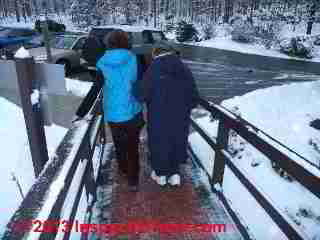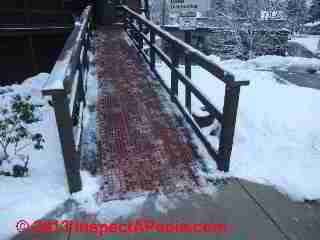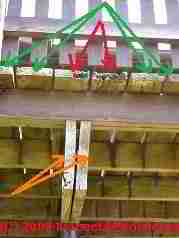 Building Access Ramp Slip Prevention:
Building Access Ramp Slip Prevention:
improve ramp surfaces to prevent slips, trips, falls
- POST a QUESTION or COMMENT about building access ramp construction codes, specifications, hazards, & safety improvements
Building access ramp slip trip and fall hazard reduction: how do we make sloped walking surfaces less slippery?.
InspectAPedia tolerates no conflicts of interest. We have no relationship with advertisers, products, or services discussed at this website.
- Daniel Friedman, Publisher/Editor/Author - See WHO ARE WE?
How Do We Make A Slippery, Dangerous Access Ramp Safer?
Typical building code specifications for access ramp non-slip surface requirements & surface maintenance conditions
The surface of ramps shall be of slip-resistant materials that are securely attached. - Florida building code, 1010.7.1 Ramp Surface
Outdoor ramps and outdoor approaches to ramps shall be designed so that water will not accumulate on walking surfaces. - Florida building code, 1010.7.2 Outdoor Conditions. Note that in freezing climates similar concern for accumulation of ice or snow must be addressed as must be algae or other slippery materials.
Curiously, since it's common for people to drill holes in wooden walks, steps, decks, ramps to try to improve drainage (especially where a cupped board may retain water), the same Florida building code specifies
The ramp floor and landings shall be solid and without perforations. - Florida building code, 1010.7.4
Watch out: the slipperiness of a ramp varies enormously depending on what is on its surface, including algae, sand, dust, dirt, water, snow, ice, and even some add-on walking surfaces and paints.
At SLIPPERY STAIRS, WALKS, ROOFS we discuss the SCOF for wet algae-covered surfaces.
Also ake a look at BARK SIDE UP on DECKS & STEPS for details about water retention in cupped wood surfaces.
 How to make access ramps less slippery
How to make access ramps less slippery
Remove slippery materials: clean algae or other slippery materials from the surface - if necessary using deck cleaner and a power washer.
[Click to enlarge any image]
Where possible, correct the underlying conditions that cause algae or other debris collection on a ramp surface - sometimes simply by cutting back overhanging tree branches, the added sunlight will reduce algae growth as well as frost or ice formation.
Improve ramp surface traction: for a ramp that will be used for both wheelchairs and walking pedestrians, install anti-slip tread materials or use an anti-slip paint; be sure that you select outdoor-rated materials if the ramp is outside.
For a ramp that is used only by walkers (no wheelchairs) some builders install cleats, typically 16" o.c. across the ramp but in our opinion, the cleats can themselves form a trip hazard and may violate building codes. Instead, if the ramp is so steep that you are considering cleats, fix the ramp slope, as we discuss below.
Correct a slippery, too-steep building access ramp by extending its length and thus reducing the pitch or slope, OR by lifting the low-end of the ramp up, building a step up at its entry end so that the ramp slope itself is reduced to a safe degree, in both cases combined with the steps above.
I.e. change the ramp length or lift its low end and add a step up, so as to keep the ramp slope to no more than 1 in 12. But adding a step at the lower end of the ramp, reducing its slope, only works for ramps that do not need to be wheelchair accessible.

Place ramp boards right-side up: as we explain
it's a bit more subtle, but during ramp construction, if the ramp surface is constructed of 2x lumber (such as pressure treated 2x6 boards, a common choice for outside building ramps), look at the ends of each board before it is nailed in place, and flip the board so that the "bark side" will be facing upwards to better drain and to avoid upwards-facing cups in ramp boards - a source of wear, algae and ice formation. .
See BARK SIDE UP on DECKS & STEPS for details about this topic and for a clear answer to the question of which way deck and ramp boards should be placed: bark side up or down.
Which way is right side up? We want any board concave cups to face "down" and arches to face with the convex or arched side "up" as the board cures.
If you click to enlarge the photo at left you might notice that the two most-rotted deck boards (photo center) were installed "upside down" with boards cupped upwards or "concave"; you can also plainly see the end grain in the two 3x12's forming the deck girder (photo lower center).
You'll see by the wood end grain pattern that the girder right-hand board has it's "bark side" facing right, and the left hand board has its "bark side" facing left.
Cupped ramp boards (or deck and platform boards) hold water and form algae or ice more quickly than boards that drain properly.
They sometimes rot faster too, as we show in our photograph. Look at the end-grain of any deck, ramp, or wooden walkway board and notice the curved lines that mark the winter wood layers of the tree from which the board was cut.
If these lines arch "upwards" when the board is placed, most boards will also be curved upwards (convex) and will drain better.
But before nailing a deck or ramp board in place, look at the board surface itself - sometimes the boards don't follow these "cupping rules".
...
Continue reading at SNAG HAZARDS on STAIRWAYS or select a topic from the closely-related articles below, or see the complete ARTICLE INDEX.
Or see these
Recommended Articles
Suggested citation for this web page
RAMP SLIP TRIP FALL REDUCTION at InspectApedia.com - online encyclopedia of building & environmental inspection, testing, diagnosis, repair, & problem prevention advice.
Or see this
INDEX to RELATED ARTICLES: ARTICLE INDEX to STAIRS RAILINGS LANDINGS RAMPS
Or use the SEARCH BOX found below to Ask a Question or Search InspectApedia
Ask a Question or Search InspectApedia
Try the search box just below, or if you prefer, post a question or comment in the Comments box below and we will respond promptly.
Search the InspectApedia website
Note: appearance of your Comment below may be delayed: if your comment contains an image, photograph, web link, or text that looks to the software as if it might be a web link, your posting will appear after it has been approved by a moderator. Apologies for the delay.
Only one image can be added per comment but you can post as many comments, and therefore images, as you like.
You will not receive a notification when a response to your question has been posted.
Please bookmark this page to make it easy for you to check back for our response.
IF above you see "Comment Form is loading comments..." then COMMENT BOX - countable.ca / bawkbox.com IS NOT WORKING.
In any case you are welcome to send an email directly to us at InspectApedia.com at editor@inspectApedia.com
We'll reply to you directly. Please help us help you by noting, in your email, the URL of the InspectApedia page where you wanted to comment.
Citations & References
In addition to any citations in the article above, a full list is available on request.
- Access Ramp building codes:
- UBC 1003.3.4.3
- BOCA 1016.3
- ADA 4.8.2
- IBC 1010.2
- Access Ramp Standards:
- ADA (Americans with Disabilities Act), Public Law 101-336. 7/26/90 is very often cited by other sources for good design of stairs and ramps etc. even where disabled individuals are not the design target.
- ANSI A117.4 Accessible and Usable buildings and Facilities (earlier version was incorporated into the ADA)
- ASTM F 1637, Standard Practice for Safe Walking Surfaces, (Similar to the above standards)
- Slips, Trips, Missteps and Their Consequences, Second Edition, Gary M. Bakken, H. Harvey Cohen,A. S. Hyde, Jon R. Abele, ISBN-13: 978-1-933264-01-1 or ISBN 10: 1-933264-01-2, available from the publisher, Lawyers & Judges Publishing Company,Inc., www.lawyersandjudges.com sales@lawyersandjudges.com
- The Stairway Manufacturers' Association, (877) 500-5759, provides a pictorial guide to the stair and railing portion of the International Residential Code. [copy on file as http://www.stairways.org/pdf/2006%20Stair%20IRC%20SCREEN.pdf ] -
- The following stair books and other books on stair history, design, and architecture can be purchased at our Amazon-Supported InspectAPedia Bookstore
- Falls and Related Injuries: Slips, Trips, Missteps, and Their Consequences, Lawyers & Judges Publishing, (June 2002), ISBN-10: 0913875430 ISBN-13: 978-0913875438
"Falls in the home and public places are the second leading cause of unintentional injury deaths in the United States, but are overlooked in most literature. This book is unique in that it is entirely devoted to falls. Of use to primary care physicians, nurses, insurance adjusters, architects, writers of building codes, attorneys, or anyone who cares for the elderly, this book will tell you how, why, and when people will likely fall, what most likely will be injured, and how such injuries come about. " - Slips, Trips, Missteps and Their Consequences, Gary M. Bakken, H. Harvey Cohen, Jon R. Abele, Alvin S. Hyde, Cindy A. LaRue, Lawyers and Judges Publishing; 2 edition (April 2006), ISBN-10: 1933264012 ISBN-13: 978-1933264011
- In addition to citations & references found in this article, see the research citations given at the end of the related articles found at our suggested
CONTINUE READING or RECOMMENDED ARTICLES.
- Carson, Dunlop & Associates Ltd., 120 Carlton Street Suite 407, Toronto ON M5A 4K2. Tel: (416) 964-9415 1-800-268-7070 Email: info@carsondunlop.com. Alan Carson is a past president of ASHI, the American Society of Home Inspectors.
Thanks to Alan Carson and Bob Dunlop, for permission for InspectAPedia to use text excerpts from The HOME REFERENCE BOOK - the Encyclopedia of Homes and to use illustrations from The ILLUSTRATED HOME .
Carson Dunlop Associates provides extensive home inspection education and report writing material. In gratitude we provide links to tsome Carson Dunlop Associates products and services.

